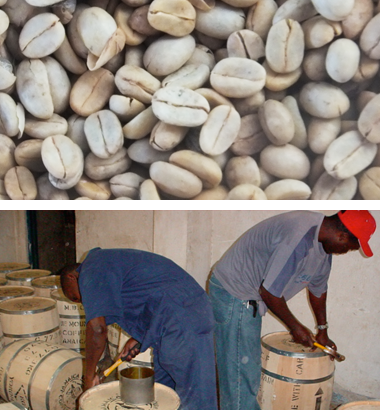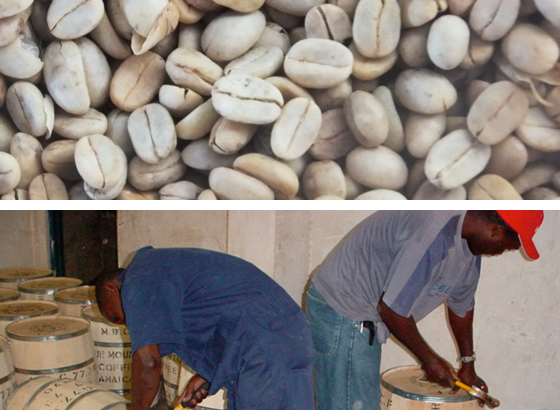UCC directly manages coffee estates in Jamaica and Hawaii, being actively involved in coffee making from planting saplings on through to harvesting the beans.
Managing a coffee estate is not without its risks: the uncertainty of nature, the challenges of maintaining fertile soil and caring for crops, and more.
However, UCC founder Tadao Ueshima was committed to developing quality coffee by hand and delivering the genuine article to customers. With the operation of these estates, Tadao's vision lives on. From the careful planting of each sapling to the harvest of the final beans, deploying the latest technologies where necessary, we develop the finest quality coffee beans that remain true to the ethos of Tadao.
Blue Mountain coffee is famous for its balanced flavor.
This "king" of coffee beans is grown and harvested at our estates in the Caribbean.

Blue Mountain coffee is only produced in the mountainous region of eastern Jamaica. The flavorful beans are grown in limited quantities; originally, almost this entire crop was exported to Japan, but that only amounted to 1% of the coffee beans consumed in the entirety of the country. Tadao Ueshima launched a directly-managed Blue Mountain estate in Jamaica in order to develop a stable supply of this rare, high-quality coffee. It goes without saying that this was a first in the coffee industry in Japan.
The Blue Mountain area may be the ideal growing environment for coffee, but it has a challenging climate for people to manage. As a mountainous terrain located 800-900 meters above sea level, there are places where the inclination reaches a steep forty degrees. These precipitous paths are treacherous for even the most experienced climbers, so the work is physically demanding.
Coffee plants are first grown to saplings and then transplanted to the coffee estate. Many estates simply purchase ready-grown saplings, but UCC is committed to quality, so we select only the most solid and substantial coffee cherries and use them to grow saplings one at a time in rubber pots.




At the Mavis Bank Central Factory, products are graded and the beans divided. They then move on to a tasting phase and a sample is sent to the Coffee Industry Board (CIB). Only those beans that have received a mark of Blue Mountain No. 1, No. 2, or No. 3 from CIB are then labeled as Blue Mountain Coffee Craighton Estate by MBCF and shipped in wooden barrels.
A sample of all coffee shipping to UCC is first sent to Japan, where it is inspected by our coffee “classificadors” (appraisers). Only then is the coffee that meets their checks loaded on barges. When the coffee arrives in Japan, it is again inspected by classificadors to ensure that it is of the same quality as the originally sampled beans. Once this check is complete, the coffee makes its way throughout Japan.

In 2008, UCC’s coffee estate was the first in the Caribbean to get Rainforest Alliance Certified.
While expanding our estates and creating new employment opportunities to better contribute to society, we are also working with the Coffee Industry Board to trial new cultivation methods. In addition, we dispatch Japanese coffee experts to neighboring farms in order to improve the technical expertise of the area and further stimulate the Jamaican economy.
“The Rainforest Alliance ”
The Rainforest Alliance is working towards a world where people and nature thrive in harmony. They are building a powerful alliance with farmers, businesses, consumers and others. To learn more about the Rainforest Alliance, visit www.rainforest-alliance.org.
Hawaiian Kona coffee is one of the benchmarks of high quality coffee.
The fresh and delicious taste of coffee from a tropical paradise.

In 1989, UCC opened its second directly-managed coffee estate, the UCC Hawaii Kona Coffee Estate.
Developing this plot of land was no mean feat. The Kona area is built on volcanic rock from the Hualalai volcano. That means that when it rains, the rainwater fails to penetrate the topsoil. We were tasked with dragging out the volcanic bedrock, breaking it down, and retilling the soil underneath. Some of the volcanic rock was so hard that it required dynamite to break apart. The initial irrigation work at the time of the estate's opening was also insufficient, causing the land to frequently shift. Seeking to protect the environment and create a stable area with no risk of mudslides, we revamped the estate to feature the latest irrigation facilities.
Seeking to develop high quality coffee, UCC first grows each sapling one tree at a time. We also employ grafting techniques to develop strong trees that will yield healthy coffee beans. At the UCC Hawaii Kona Coffee Estate, we utilize cutting-edge trickle irrigation and other cultivation techniques.



When shipping coffee beans for export, they are prepared as green coffee beans. Coffee cherries are processed from the plants into green coffee beans following a process that differs by production region; Hawaiian Kona coffee achieves this by the wet method.
The pulp of the coffee cherry is removed, and coffee is parched. Once dried, the shell is removed, leaving the raw bean. The beans are then sorted by grade and packed in hemp bags.
